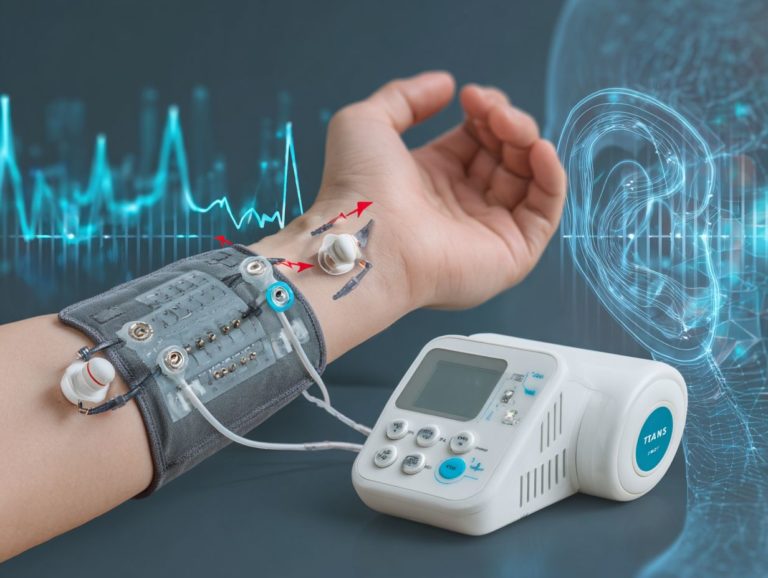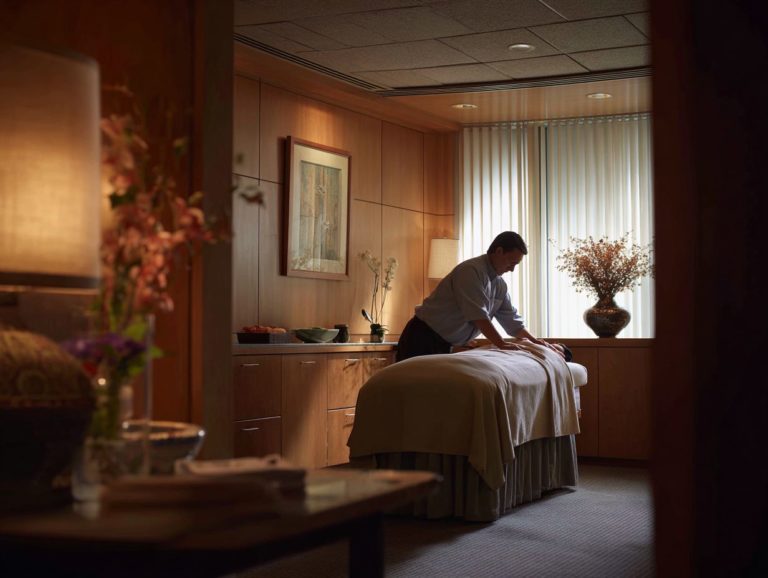Acupuncture for Rib Fractures: Techniques and Effectiveness
A traumatic rib fracture can be extremely painful, but acupuncture provides an effective way to manage pain. This old method uses both regular needle insertion and new laser acupuncture to improve pain relief through acupuncture. This article discusses how acupuncture can help reduce pain from rib fractures. It looks at useful methods and provides proof of its success. Learn how this complete method could change your recovery process.
Key Takeaways:
Contents
- 1 Understanding Rib Fractures
- 2 Mechanism of Acupuncture
- 3 Acupuncture Techniques for Rib Fractures
- 4 Effectiveness of Acupuncture for Rib Fractures
- 5 Acupuncture for Rib Fractures: Clinical Trial Data
- 6 Benefits of Acupuncture in Recovery
- 7 Potential Risks and Considerations
- 8 Frequently Asked Questions
- 8.1 What is acupuncture and how does it help with rib fractures?
- 8.2 What are the techniques used in acupuncture for rib fractures?
- 8.3 Is acupuncture for rib fractures painful?
- 8.4 How effective is acupuncture for rib fractures?
- 8.5 Are there any risks or side effects of using acupuncture for rib fractures?
- 8.6 How many sessions of acupuncture are needed for rib fractures?
Definition of Acupuncture
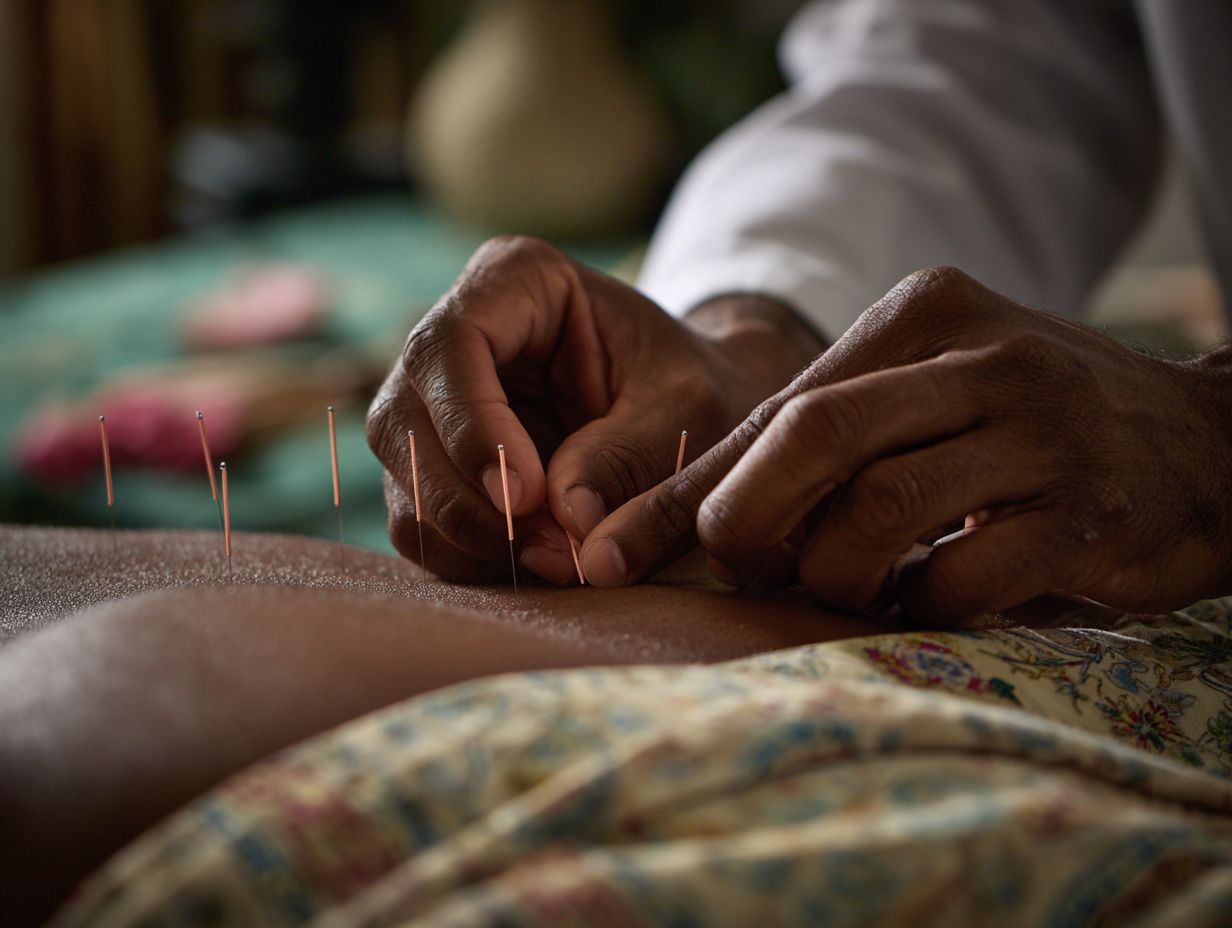
Acupuncture involves the insertion of fine needles into specific body points to stimulate the meridians, promoting pain relief and healing.
This practice is rooted in the concept of Qi, or life energy, which flows through the body. By targeting specific points, acupuncture aids in restoring balance and alleviating discomfort. A recent publication in ScienceDirect provides a modern basis for understanding these meridians, offering insights into their role in traditional Chinese medicine.
For instance, studies show that acupuncture can effectively reduce chronic pain, comparable to contemporary analgesic methods such as non-steroidal anti-inflammatory drugs (NSAIDs).
Today, many practitioners also integrate acupuncture with techniques like electrical stimulation or cupping therapy, enhancing its efficacy in pain management.
This method treats symptoms and encourages general health.
History and Origins
Acupuncture started in China over 2,500 years ago. It began as a mystical practice and is now a common method for treating pain.
The foundational text, the Huangdi Neijing, detailed the principles of acupuncture, emphasizing balance and the flow of Qi (energy) throughout the body.
As early as the 16th century, European scholars began to recognize acupuncture, but it gained significant traction in the West during the 20th century, particularly after President Nixon’s visit to China in 1972.
Today, acupuncture is integrated into various healthcare systems, often used alongside conventional medicine for treating conditions such as chronic pain, anxiety, and headaches, showcasing its therapeutic versatility. For expanded context, the Encyclopedia Britannica explores the historical development and scientific understanding of acupuncture.
Understanding Rib Fractures
Broken ribs are frequent chest injuries that can cause major problems, such as intense pain and breathing difficulties. For those exploring alternative pain management options, acupuncture offers mechanisms and insights that might be worth considering.
Types of Rib Fractures
Rib fractures have different types: simple, compound, and flail chest, each causing different medical problems.
Simple rib fractures involve a single crack in the bone, often caused by a fall or direct blow. The symptoms typically include localized pain and tenderness that worsens with movement or deep breathing.
Compound fractures, on the other hand, occur when a rib breaks and punctures the skin, posing a risk of infection and requiring surgical intervention.
Flail chest is a serious condition where multiple ribs are broken in several places, causing part of the chest wall to become detached from the rest. This causes serious breathing problems, requiring urgent medical care to stabilize the patient and possibly use a ventilator.
Common Causes and Risk Factors
Common causes of rib fractures include direct trauma from accidents, falls, or heavy impacts, with risk factors including age and osteoporosis.
Complications from rib fractures can arise, notably respiratory issues like pneumonia due to shallow breathing from pain. To manage this, patients often rely on analgesics such as ibuprofen or acetaminophen.
For effective pain management, using a rotating regimen of these medications can provide better relief while minimizing side effects. According to Mayo Clinic, deep breathing exercises can help prevent complications; start with small, controlled breaths to gradually expand lung capacity.
Monitor your pain levels to adjust activities and rest periods, ensuring a safer recovery process.
Symptoms and Diagnosis
Patients may present with localized pain, difficulty breathing, and decreased lung volume, often diagnosed through physical examination and imaging.
To confirm a rib fracture, clinicians typically perform a thorough physical examination, assessing for tenderness and deformities.
Imaging techniques like X-rays are commonly used, though CT scans provide greater detail, especially in complex cases.
Pain is assessed using the Numeric Rating Scale, which asks patients to rate their discomfort on a scale from 0 (no pain) to 10 (worst pain imaginable). This helps assess how serious the condition is and adjust the treatment to fit.
Additional tests may include lung function assessments to evaluate any impact on respiratory capacity.
Mechanism of Acupuncture
Knowing how acupuncture works is important for recognizing how well it can relieve pain in cases like broken ribs. For a deeper understanding of its applications, see also: Acupuncture: Methods, Benefits, and Pain Relief Applications.
How Acupuncture Works
Acupuncture works by stimulating the nervous system, which in turn releases neurotransmitters, enhancing analgesic efficacy and promoting healing.
This stimulation affects pain pathways, such as the release of endorphins, which are natural painkillers. Acupuncture modulates the autonomic nervous system, balancing the sympathetic and parasympathetic responses.
For example, studies have shown that needle placement at specific points, like LI4 (Hegu), can effectively reduce tension and trigger relaxation. Many practitioners use tools like electroacupuncture, which adds a small electrical current to increase the effects.
This method helps with pain relief and also better mental and physical health by reducing stress and anxiety.
Key Meridians and Points for Rib Pain
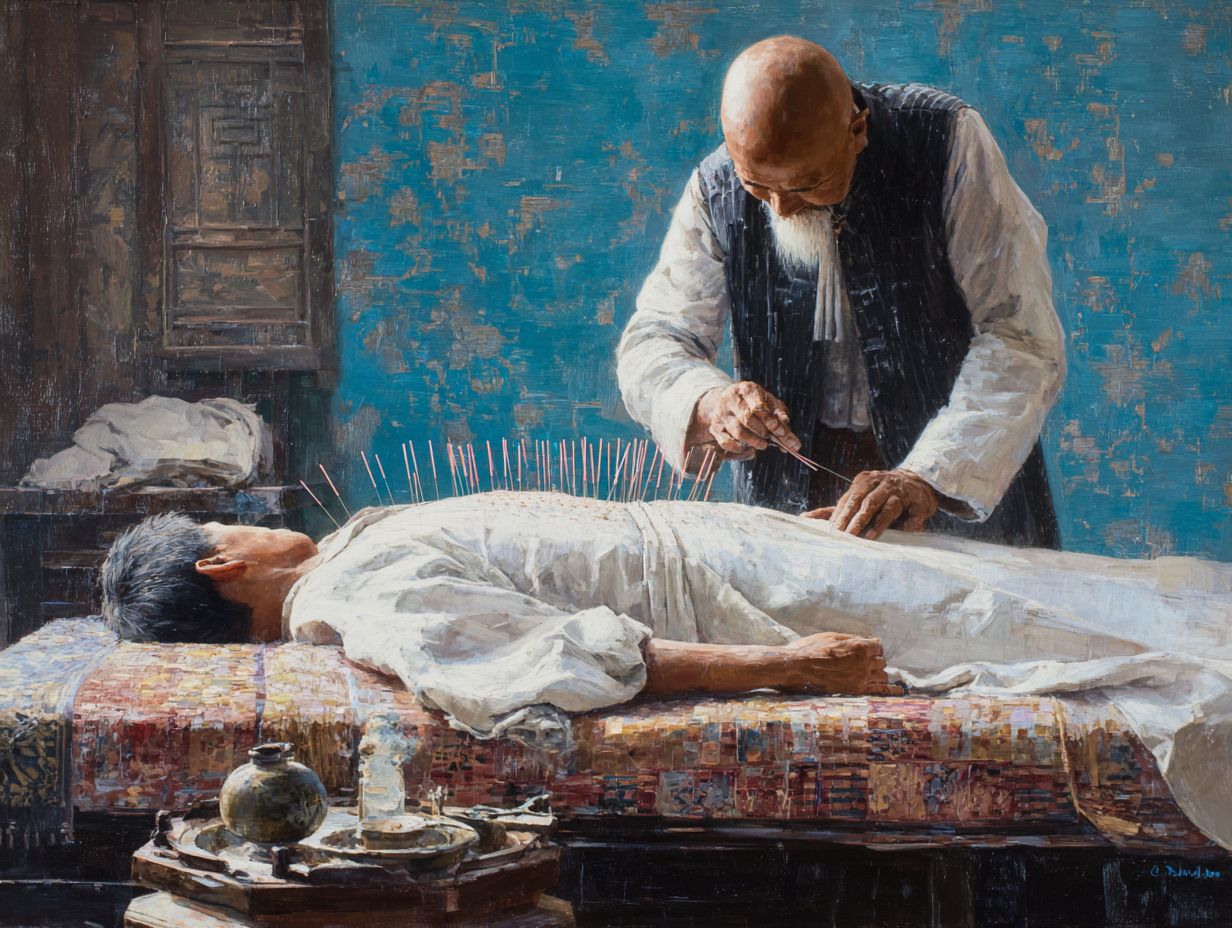
Certain acupuncture points along meridians, like Lung 1 (Zhongfu) and Liver 14 (Qimen), are important in effectively managing rib pain.
Lung 1 is located near the front of the chest and can alleviate pain by improving lung function and reducing tension in the surrounding muscles.
Likewise, Liver 14, found on the ribcage, acts on the liver and gallbladder, helping to relieve emotional tension that may contribute to physical discomfort.
To improve treatment, practitioners might use needling these points together with herbal supplements like turmeric to reduce inflammation.
Regular sessions, ideally weekly, allow for ongoing assessment and adjustment, promoting optimal recovery and pain relief.
Acupuncture Techniques for Rib Fractures
Different acupuncture methods can be used to improve pain management and healing in patients with broken ribs. To understand the various techniques available, you might find it helpful to explore our insights on manual acupuncture techniques which detail the distinctions and certifications in the US.
Needle Insertion Techniques
The way needles are inserted can differ. The depth and angle are adjusted based on the patient’s particular pain and body structure.
For effective treatment of rib pain, first identify the site of pain and palpate the area to assess muscle tension.
Typically, insert the needle at a 30 to 45-degree angle to the skin to access the muscle layers without risking injury to underlying structures. Aim for a depth of 1 to 2 inches, depending on the patient’s body composition.
Always use aseptic techniques and consider patient comfort. Watching how the patient reacts during the procedure helps make changes for the best treatment results.
Electro-Acupuncture
Electro-acupuncture involves applying electrical stimulation to acupuncture needles, enhancing analgesic efficacy and promoting quicker recovery.
This technique is particularly useful for patients recovering from rib fractures, as it can significantly reduce pain and inflammation. Clinical studies have demonstrated that combining electro-acupuncture with traditional physical therapy leads to faster healing times and improved mobility.
To implement this method, practitioners typically apply needles at specific acupoints around the rib area and connect them to a low-frequency electrical device for 15-30 minutes per session, two to three times a week.
This method reduces pain and helps more blood reach the injured area, which helps with healing.
Acupressure as an Alternative
Acupressure, an accessible alternative to acupuncture, uses finger pressure on specific points to relieve pain and discomfort associated with rib fractures.
To self-administer acupressure for rib fracture pain, focus on key pressure points.
Begin with the ‘Liver 3’ point, which is between your big toe and the second toe. Press down firmly for a few seconds. Next, target ‘Spleen 6,’ found above the ankle on the inner lower leg, which may help with overall pain relief.
Apply pressure to the ‘Kidney 27’ points, located beneath your collarbone, to directly address chest discomfort. Do these techniques for 1-2 minutes, multiple times a day, to improve blood flow, support healing, and help manage pain.
Effectiveness of Acupuncture for Rib Fractures
Many studies show that acupuncture can help reduce pain and improve healing for rib fractures.
Acupuncture for Rib Fractures: Clinical Trial Data
Acupuncture for Rib Fractures: Clinical Trial Data
Pain Management Efficacy: Pain Reduction
Pain Management Efficacy: Group Outcomes
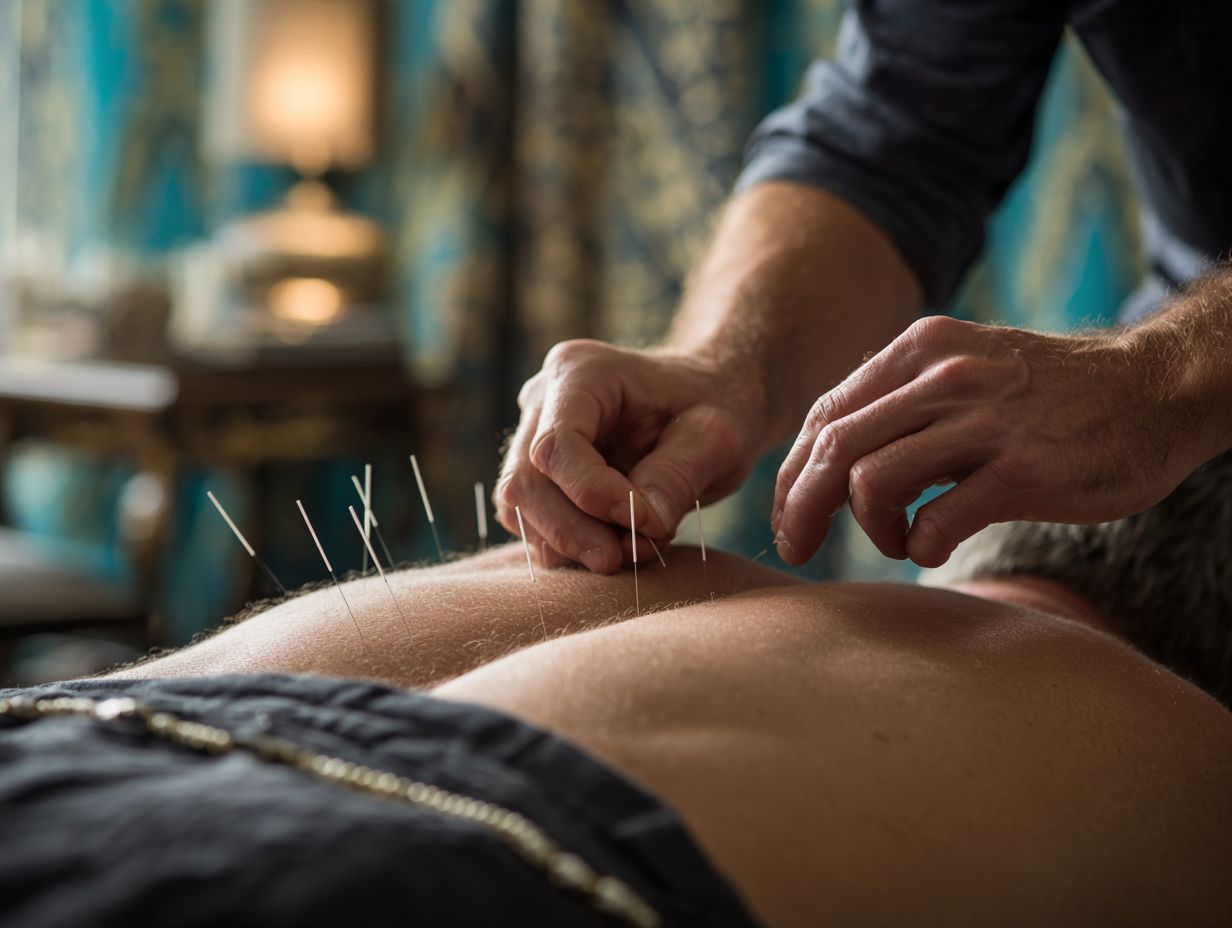
The clinical trial data on Acupuncture for Rib Fractures focuses on the efficacy of acupuncture for pain management and the outcomes related to its application. Two groups were studied: the Traditional Acupuncture (TA) group and the Laser Acupuncture (LA) group, offering a comparison of their effectiveness and safety.
Pain Management Efficacy is a critical aspect of the trial, where both the TA and LA groups experienced a significant average pain intensity reduction of 17%. This indicates that acupuncture, whether traditional or laser-based, has a measurable impact on alleviating pain for patients with rib fractures. Such results can reinforce the use of acupuncture as a viable option for pain relief in clinical settings.
Group Outcomes further elaborate on the trial’s effectiveness and safety profile. The completion rate for participants was notably high at 90.83%, demonstrating that a majority of patients were able to complete the therapy regimen without dropping out. This high completion rate shows that acupuncture treatments are practical and well-received by patients with rib fractures.
- Pneumothorax Complication Rate (TA Group): The occurrence of pneumothorax, a potential complication involving air leakage into the space between the lung and chest wall, was recorded at 2.7% for the Traditional Acupuncture group. This relatively low rate suggests that traditional acupuncture is generally safe, with minimal risk of causing this specific complication.
- Pneumonia Complication Rate (LA Group): Similarly, the Laser Acupuncture group experienced a 2.7% rate of pneumonia, an infection that inflames the air sacs in the lungs. This indicates that laser acupuncture does not significantly increase the risk of pneumonia, reaffirming its safety for patients.
The Acupuncture for Rib Fractures Data from clinical trials shows clear proof that both traditional and laser acupuncture can lower pain intensity by 17%. Complications like pneumothorax and pneumonia are rare, happening in 2.7% of cases. The high completion rate of 90.83% suggests that acupuncture is a well-tolerated and practical intervention for managing pain in patients with rib fractures.
Clinical Studies and Evidence
A randomized controlled trial at Kaohsiung Chang Gung Memorial Hospital demonstrated a significant reduction in pain levels among patients receiving acupuncture after rib fractures.
The study reported a 30% decrease in pain scores measured by the Visual Analog Scale within two weeks of treatment. Participants found it easier to move and returned to their daily activities more quickly.
Acupuncture treatments were done two times a week, using spots such as LI4 (Hegu) and ST36 (Zusanli), which help with easing pain and promoting recovery.
Including acupuncture in treatment plans might be a helpful choice for handling rib fracture pain, especially for patients looking for additional therapies.
Patient Testimonials
Patient testimonials often highlight acupuncture’s role in alleviating pain and enhancing mobility during recovery from rib fractures.
Many patients report significant improvements after just a few sessions. For example, one patient shared that after four treatments, their pain level dropped from an 8 to a 3 on the scale, which allowed them to resume daily activities like walking and stretching.
Acupuncturists often tailor treatments based on individual needs, utilizing techniques such as trigger point therapy to specifically target areas of tension.
Tools like acupuncture needles and electrical stimulation devices improve results, helping with pain relief and speeding up recovery times.
Benefits of Acupuncture in Recovery
Acupuncture can aid rib fracture recovery by reducing pain and easing swelling.
Pain Management
Acupuncture has been shown to reduce reliance on analgesics by effectively managing pain levels related to rib fractures.
In a study published in the Journal of Pain Research, patients receiving acupuncture reported a 30% reduction in pain intensity after just six sessions.
Techniques such as needling specific points related to respiratory function can also improve lung capacity, enhancing overall recovery.
For the best outcomes, patients can visit acupuncturists who use both traditional techniques and electro-acupuncture to reach deeper tissues.
Adding acupuncture to a complete plan for managing pain, which also includes physical therapy, can make patients happier and lead to better results.
Reduction of Inflammation
By stimulating key acupuncture points, patients often experience significant reductions in inflammation, facilitating faster healing post-fracture.
This reduction occurs because acupuncture increases blood flow and encourages the release of substances that reduce inflammation.
For instance, researchers have found that treatment targeting points like LI4 and ST36 can significantly decrease swelling in affected areas.
Incorporating acupuncture into a recovery regimen may reduce reliance on pain medications, minimizing side effects.
To get the most out of their treatment, patients can use acupuncture along with physical therapy, attending sessions two to three times a week during the recovery period, which usually lasts 4-6 weeks.
This combined method encourages a complete healing atmosphere.
Potential Risks and Considerations
Acupuncture is generally safe, but you should be aware of possible risks and issues to make informed choices about treatment. To better understand these safety concerns, explore our detailed guide on acupuncture risks and side effects.
Side Effects of Acupuncture
Common side effects of acupuncture may include mild bruising, soreness, or temporary fatigue, but serious complications are rare.
To minimize these risks, consider a few key recommendations.
- Make sure your acupuncturist has a license and knows what they’re doing to lower the risk of problems.
- Communicate openly about your medical history and any medications you are on, as certain conditions may influence your response to treatment.
- Stay hydrated post-session, as this can help counteract feelings of fatigue.
By following these guidelines, you can enjoy the benefits of acupuncture with greater confidence and less concern about side effects.
When to Avoid Acupuncture
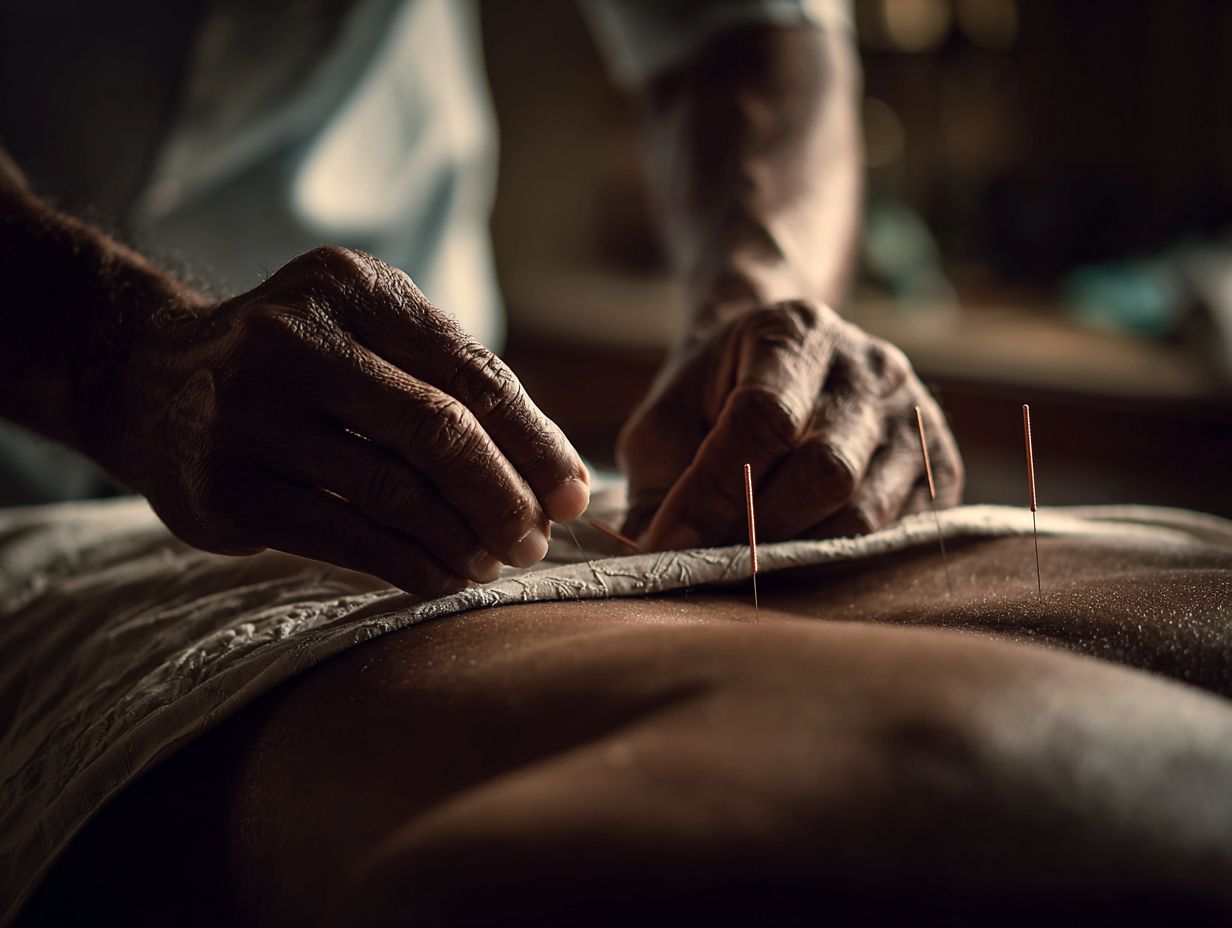
If you have conditions such as bleeding disorders or serious infections, you should be cautious or skip acupuncture treatments.
In addition, individuals on blood-thinning medications, such as warfarin or aspirin, should consult a healthcare professional before undergoing acupuncture, as it may increase bleeding risks.
Pregnant women are advised to avoid acupuncture in the first trimester to prevent complications. People with weak immune systems or serious skin problems should talk to a doctor because acupuncture might be risky for them.
Talk to your acupuncturist about any health issues for safe treatment.
Future Research Directions
More studies should carry out detailed randomized controlled trials to verify if acupuncture works and to refine treatment methods for rib fractures.
Broadening acupuncture studies can provide important knowledge about its possible uses. Looking into different demographic groups-like age and existing health conditions-will allow for more customized treatment plans.
Looking at how combining acupuncture with other treatments, such as physical therapy or medication, can improve patient results. Studying certain acupuncture points and methods can help identify the best ways to manage pain and speed up recovery after an injury.
Working together in diverse groups can encourage new research, helping acupuncture become a part of overall health practices.
Frequently Asked Questions
What is acupuncture and how does it help with rib fractures?
Acupuncture is a form of traditional Chinese medicine that involves inserting thin needles into specific points on the body to stimulate the flow of energy. It can help with rib fractures by promoting healing, reducing pain and inflammation, and improving overall well-being.
What are the techniques used in acupuncture for rib fractures?
The methods applied in acupuncture for broken ribs can differ based on how bad the break is and where it is located. Common techniques include local needling around the affected area, electroacupuncture, and moxibustion, a method that involves burning a herb near the skin to create heat and stimulate blood flow.
Is acupuncture for rib fractures painful?
Acupuncture is generally not painful, though some may experience a slight sensation or tingling when the needles are inserted. The needles used in acupuncture for rib fractures are very slender and bendable, so the process is mostly pain-free.
How effective is acupuncture for rib fractures?
Research has shown promising results for the effectiveness of acupuncture in treating rib fractures. It can help reduce pain and inflammation, promote healing, and improve overall well-being. However, you should talk to a licensed acupuncturist to get a treatment plan made just for you.
Are there any risks or side effects of using acupuncture for rib fractures?
Acupuncture is generally considered a safe and low-risk treatment for rib fractures. On rare occasions, you might experience bruising or light bleeding where the needle is inserted. It is important to inform the acupuncturist of any pre-existing medical conditions or medications before undergoing treatment.
How many sessions of acupuncture are needed for rib fractures?
The required number of acupuncture treatments for rib fractures can differ based on the person and how serious the injury is. It is common to have multiple sessions over the course of a few weeks for optimal results. However, you can talk this over with a certified acupuncturist during the first meeting.

Sheetal Sharda has a background in CS. She got an interest in Holistic living back in 2018, and has since started exploring more into Naturapathy, Holistic Living, Yoga, and more. She got inspired to start SereneClinics to help people find reliable centers across the world.

